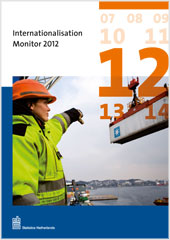Internationalisation Monitor 2012


The process of economic globalisation is characterised by increasing international trade, foreign direct investment and a growing role of multinational enterprises, reflecting the increasing interconnectedness of national economies. The effects of globalisation for economic growth, innovation, employment and sustainability are often topics of discussion for policymakers and the public. What opportunities for growth are still available to Dutch enterprises and which enterprises are capable of seizing these opportunities? Is the foundation of a new internationally oriented enterprise more beneficial to the Dutch economy in terms of turnover or jobs (and a closure more detrimental) than that of an enterprise that focuses solely on the domestic market? Which part of the economy did the financial crisis of 2009 hit the hardest and which enterprises have best overcome the downturn?
This fifth edition of the Internationalisation Monitor describes recent developments in international trade in goods and services, foreign direct investment, multinational enterprises, and traffic and transport. In addition, four analytical chapters provide an in-depth analysis of enterprise dynamics and the role of (increasing) internationalisation in this respect.
Some important findings in this edition are:
- Almost 60 percent of all newly established enterprises in 2007 survived for at least five years. From the moment of birth, enterprises under foreign control are larger than Dutch-controlled enterprises. However, comparable new Dutch-controlled firms grew faster on average.
- International trade has a significantly positive impact on a company’s chance of survival. The highest survival rate is found for enterprises active in both imports and exports.
- The partner country with which an enterprise trades also has an impact on survival. Enterprises that mainly import from the BRIC and Asian countries seem to have a lower survival rate than those that mainly import from the EU-15 and North America.
- Internationally active enterprises were especially hard hit by the financial crisis of 2008/2009. Their turnover and trade declined spectacularly. However, these enterprises were also among the fastest to recover. Nationally oriented and non-trading enterprises are still struggling to recover.
- Enterprises that trade with the BRIC countries are larger, more productive, more innovative and more likely to be under foreign control than non-BRIC traders. Imports from the BRIC countries are three times as large as Dutch exports to the BRIC-countries. Imports mainly consist of primary product (except for imports from China which are mainly technology intensive products). Dutch exports are mainly technology intensive products.
- The turnover of Dutch-controlled enterprises at affiliates located in the BRIC countries was much higher than that of Belgian-controlled enterprises, but similar to that of companies under German or French control.
- Dutch exports are becoming increasingly technology intensive. Compared with 1997, the share of technology intensive products in exports has increased from 25 to almost 30 percent. Re-exported products are more technology intensive than Dutch manufactured products.
- The largest concentrations of traders are found in municipalities in the province of Limburg and Dutch border regions. These are mainly small traders as almost 30 percent of Dutch imports enter and 23 percent of exports leave the Netherlands via Rotterdam, Amsterdam and Haarlemmermeer (Schiphol airport).
- The financial crisis of 2008 caused a major decrease in passenger and freight transport by air. In the following years, both transport flows started growing again, leading to a record number of passengers and volume of freight transported by air in 2011.
- Ireland is the most important destination for Dutch exports of services, followed by Germany and the United Kingdom. Poland was the fastest growing emerging export market in 2011.
- Foreign-controlled enterprises generated approximately 15 percent of Dutch GDP, accounted for 800 thousand jobs and 25 percent of private sector investment in 2010.
Internationalisation Monitor
Downloads
- PDF - 2012-m21-pub